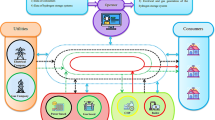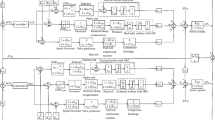Abstract
Due to the environment's instability, to reduce inconsistent power supply it is preferable to connect two or more RES in a grid. Harmonics and other power quality issues are introduced into the distribution grid as a result of integrating these Hybrid Renewable Energy Storage (HRES) with nonlinear loads, which is a significant concern for the utility and the consumers, respectively. With the use of the Unified Power Quality Conditioner (UPQC), power quality problems such as voltage interruptions, actual power, and reactive power can be reduced. For optimal operation of the series and shunt compensator of UPQC, the outputs of the converters are controlled by PWM signals, which are optimally tuned by controllers implemented with updated algorithms. An optimized Hybrid metaheuristic-assisted collateral controller comprising of fractional-order proportional integral derivative (FOPID) controller cum (proportional integral (PI) controller for the enhancement of the Three-Phase HRES system-based Distribution Grid integrated with UPQC is developed in this paper. The UPQC reduces the harmonics that non-linear loads feed into the power supply and power quality concerns. The DC link voltage regulation and controller optimization are achieved with the optimal tuning of gain parameters, fractional orders and weight parameters using a hybrid Metaheuristic Algorithm named Amplified Slime Mould with WildeBeest Herd Optimization (ASM-WHO) Algorithm. The proposed system is developed in MATLAB Simulink to compare the effectiveness of compensation for voltage sags and surges and total harmonic distortion (THD) to more traditional approaches, UPQC with PI controller, FOPID-PI controller, FOPID-PI with Chicken Swarm Optimization (CSO), SOA, SMA, and WHO optimization. The settling time for the proposed FOPID-PI controller with ASM –WHO is 147.27 s, which is 1.7%, 13.78%, 1.338% and 13.66% better than the controller without optimization, the proposed collateral controller method with either SOA or CSO or SMA, WHO optimization and PI controller respectively.









Source voltage waveform without UPQC







Similar content being viewed by others
Data availability
Data sharing is not applicable to this article as no new data were created or analyzed in this study.
References
Abou El-Ela AA, El-Sehiemy RA, Shaheen AM, Shalaby AS (2022) Aquila optimization algorithm for wind energy potential assessment relying on Weibull parameters estimation. Wind 2(4):617–635
Alam SJ, Arya SR (2020) Observer‐based control for UPQC‐S with optimized gains of PI controller. Int Trans Electr Energy Syst 30(7): e47233.
Amali D, Dinakaran M (2019) Wildebeest herd optimization: a new global optimization algorithm inspired by wildebeest herding behaviour. J Intell Fuzzy Syst 37(6):8063–8076
Ben-Shahar R, Coe MJ (1992) The relationships between soil factors, grass nutrients and the foraging behaviour of wildebeest and zebra. Oecologia 90(3):422–428
Carrasco JM, Franquelo LG, Bialasiewicz JT, Galván E, PortilloGuisado RC, Prats MM, León JI, Moreno-Alfonso N (2006) Power-electronic systems for the grid integration of renewable energy sources A survey. IEEE Trans Industr Electron 4:1002–1016
D’Angelo G, Ficco M, Robustelli A An association rules-based approach for anomaly detection on CAN-bus, In: International conference on computational science and its applications, pp. 174–190. Cham: Springer Nature Switzerland, 2023
Devassy S, Singh B (2017) Design and performance analysis of three-phase solar PV integrated UPQC. IEEE Trans Ind Appl 54(1):73–81
Gianni D'Angelo, Eslam Farsimadan, Massimo Ficco, Francesco Palmieri, Antonio Robustelli, Privacy-preserving malware detection in Android-based IoT devices through federated Markov chains, Future Generation Computer Systems, https://doi.org/10.1016/j.future.2023.05.021.
Gowrishankar A, Ramasamy M (2020) SPV-based UPQC with modified power angle control scheme for the enhancement of power quality. J Circ Syst Comput 29(04):2050064
Goud BS, Loveswara Rao B (2021) Power quality enhancement in grid-connected PV/wind/battery using UPQC: atom search optimization. J Electr Eng Technol 16(2): 821–835.
Javadi A, Hamadi A, Woodward L, Al-Haddad K (2016) Experimental investigation on a hybrid series active power compensator to improve the power quality of typical households. IEEE Trans Industr Electron 63(8):4849–4859
Jin T, Chen Y, Guo J, Wang M, Mohamed MA (2020) An effective compensation control strategy for power quality enhancement of unified power quality conditioner. Energy Rep 6:2167–2179
Jumani TA, Mustafa MW, Hussain Z, Md Rasid M, Salman Saeed M, Memon MM, Khan I, Nisar KS (2020) Jaya optimization algorithm for transient response and stability enhancement of a fractional-order PID based automatic voltage regulator system. Alexandria Eng J 59(4): 2429–2440.
Kumar S, Mallesham G (2020) Performance of three phase AI controller based UPQC to enhance power quality of hybrid RES. Microsystem Technologies 26(8): 2673–2682.
Kumar CP, Pragaspathy S, Karthikeyan V, Durga Prakash KNS Power quality improvement for a hybrid renewable farm using UPQC. In: 2021 International conference on artificial intelligence and smart systems (ICAIS), pp. 1483–1488. IEEE, 2021.
Khadkikar V (2011) Enhancing electric power quality using UPQC: A comprehensive overview. IEEE Trans Power Electron 27(5):2284–2297
Khadanga RK, Nayak SR, Panda S, Das D, Prusty BR, Sahu PR (2022) A novel optimal robust design method for frequency regulation of three-area hybrid power system utilizing honey badger algorithm. Int Trans Electr Energy Syst 2022.
Latty T, Beekman M (2015) Slime moulds use heuristics based on within-patch experience to decide when to leave. J Exp Biol 218(8):1175–1179
Latha YK, Saibabu C, Obulesu YP (2011) Unified Power Quality Conditioner for voltage sag and harmonic mitigation of nonlinear loads. Int J Power Electron Drive Syst 1(1):65–74
Lei T, Riaz S, Zanib N, Batool M, Pan F, Zhang S Performance Analysis of grid-connected distributed generation system integrating a hybrid wind-PV farm using UPQC. Complexity 2022 (2022).
Lin L, Gen M (2009) Auto-tuning strategy for evolutionary algorithms: balancing between exploration and exploitation. Soft Comput 13(2):157–168
Li S, Chen H, Wang M, Asghar Heidari A, Mirjalili S Slime mould algorithm: A new method for stochastic optimization. Future Generation Computer Systems 111 (2020): 300–323.
Mansor MA, Hasan K, Othman MM, Mohammad Noor SZB, Musirin I (2020) Construction and performance investigation of three-phase solar PV and battery energy storage system integrated UPQC. IEEE Access 8: 103511–103538.
Mahdi DI, Gorel G (2022) Design and control of three-phase power system with wind power using a unified power quality conditioner. Energies 15(19):7074
Nanthagopal DrSC (2020) Power Quality Improvement Using Three-Phase Solar PV Integrated UPQC. Int J Modern Trends Sci Technol ISSN: 2455–3778 :: 06(07)
Naidu RPK, Meikandasivam S (2020) Power quality enhancement in a grid-connected hybrid system with coordinated PQ theory & fractional order PID controller in DPFC. Sustain Energy Grids Netw 21: 100317.
Nehrir MH, Wang C, Strunz K, Aki H, Ramakumar R, Bing J, Miao Z, Salameh Z (2011) A review of hybrid renewable/alternative energy systems for electric power generation: configurations, control, and applications. IEEE Trans Sustain Energy 2(4):392–403. https://doi.org/10.1109/TSTE.2011.2157540
O’Dwyer A (2000) A summary of PI and PID controller tuning rules for processes with time delay. Part 1: PI controller tuning rules. IFAC Proceedings Volumes 33(4):159–164
Qazi A, Hussain F, Rahim NA, Hardaker G, Alghazzawi D, Shaban K, Haruna K Towards sustainable energy: a systematic review of renewable energy sources, technologies, and public opinions. IEEE Access 2019, 7: 63837–63851. [CrossRef]
Reddy CB, Srikanth G Aymen F, Srinivasa Rao G, Bortoni EC (2021) Power Quality improvement in HRES grid connected system with FOPID based atom search optimization technique. Energies 14(18): 5812.
Sadigh AK, Smedley KM (2012) Review of voltage compensation methods in dynamic voltage restorer (DVR). In: 2012 IEEE power and energy society general meeting, pp. 1–8. IEEE
Samal S, Hota PK (2017) Power Quality Improvement by Solar Photo-voltaic/Wind Energy Integrated System Using Unified Power Quality Conditioner. In: Int J Power Electron Drive Syst (IJPEDS) 8(3): 1416–1426, ISSN: 2088–8694, https://doi.org/10.11591/ijpeds.v8i3.
Singh B, Jain C, Goel S, Chandra A, Al-Haddad K (2016) A multifunctional grid-tied solar energy conversion system with ANF-based control approach. IEEE Trans Ind Appl 52(5):3663–3672
Sivakumar M, Kannan P, Chenthur Pandian S (2019) Mitigation of PQ issues using an enhanced UPQC-based ANN approach. J Circ Syst Comput 28(03):1950046
Singh B, Chandra A, Al-Haddad K Power quality: problems and mitigation techniques. John Wiley & Sons
Subudhi B, Pradhan R (2012) A comparative study on maximum power point tracking techniques for photovoltaic power systems. IEEE Trans Sustain Energy 4(1):89–98
Thaker M, Vanak AT, Owen CR, Ogden MB, Slotow R (2010) Group dynamics of zebra and wildebeest in a woodland savanna: effects of predation risk and habitat density. PLoS ONE 5(9):e12758
Thangella R, Yarlagadda SR, Sanam J (2023) Optimal power quality improvement in a hybrid fuzzy-sliding mode MPPT control-based solar PV and BESS with UPQC, Int J of Dyn Control 11(4): 1823–1843.
Funding
This research did not receive any specific funding.
Author information
Authors and Affiliations
Corresponding author
Ethics declarations
Conflict of interest
The authors declare no conflict of interest.
Informed consent
Not Applicable.
Ethical approval
The conducted research is not related to either human or animal use.
Additional information
Publisher's Note
Springer Nature remains neutral with regard to jurisdictional claims in published maps and institutional affiliations.
Rights and permissions
Springer Nature or its licensor (e.g. a society or other partner) holds exclusive rights to this article under a publishing agreement with the author(s) or other rightsholder(s); author self-archiving of the accepted manuscript version of this article is solely governed by the terms of such publishing agreement and applicable law.
About this article
Cite this article
Yadav, S.K., Yadav, K.B. A hybrid metaheuristic assisted collateral fractional-order controller for three-phase solar PV, BESS, and wind- integrated UPQC. Soft Comput (2024). https://doi.org/10.1007/s00500-023-09507-9
Accepted:
Published:
DOI: https://doi.org/10.1007/s00500-023-09507-9




